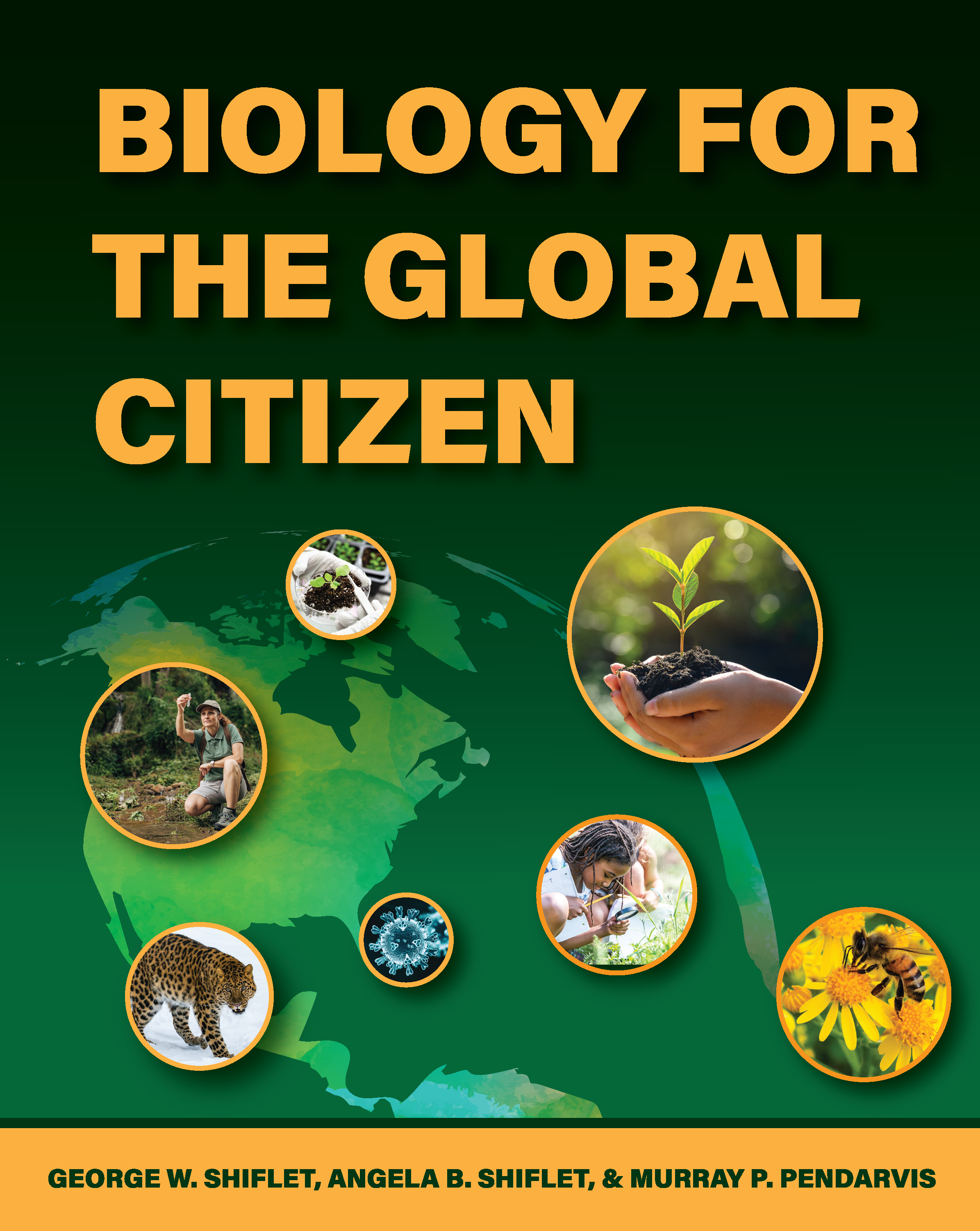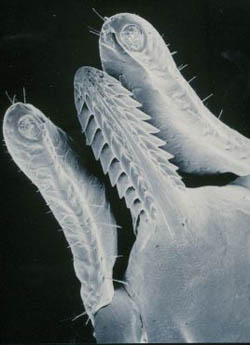in Science

|
What's News in Science 
|
Ticks: Well-Adapted Parasites
by George Shiflet
|
See “Magic Pill? Preventing Tick-Borne Diseases in Human Beings” for a discussion of recent research on a vaccine and a drug against ticks.
See “A Closer Look at Lyme Disease” for information on Lyme disease and recent research into chronic Lyme disease.
If you walked into almost any room of 100 people, you probably would be hard-pressed to find anyone interested in ticks. Naturally, most people would like to avoid these parasites, and many of them might be aware that ticks can transmit various diseases. Indeed, ticks serve commonly as vectors (organisms that transmits disease to other organisms) for infectious diseases caused by bacteria, viruses, and protozoans. The most frequently reported tick-borne disease in the U.S. is Lyme disease, caused by a bacterium, Borrelia burgdorferi, transmitted primarily by black-legged ticks, Ixodes scapularis. There were more than 400,000 cases reported in the U.S in 2022, mostly in the northeastern and upper midwestern states (Figure 1). This number is only an estimate and is likely an underestimate. Lyme Disease Case Map presents an animation of the change in the disease’s distribution over time.

Figure 1. Distribution map for reported cases of Lyme Disease in the continental U.S. in 2022.
CDC, https://www.cdc.gov/lyme/data-research/facts-stats/lyme-disease-case-map.html?CDC_AAref_Val=https://www.cdc.gov/lyme/datasurveillance/lyme-disease-maps.html.
Ticks are not insects (6 legs), but arachnids, with eight legs, more closely related to mites and spiders than any insect. They are blood-sucking ectoparasites (attack/feed from the skin surface), with many specialized, physical modifications, and most ticks belong to one family, the Ixodidae (hard ticks).
Ticks have complex life cycles that include 1-3 hosts and 4 live stages–egg, larva, nymph, and adult (Figure 2). The life cycle usually takes two to three years to complete (Figure 3).

Figure 2. Black-legged tick (all stages).
CDC, https://www.cdc.gov/lyme/causes/index.html.

Figure 3. Black-legged Tick (Ixodes scapularis) Life Cycle.
CDC, https://www.cdc.gov/lyme/causes/index.html.
After mating and then detaching from their host in the spring, females usually lay their eggs under plant litter. One female can lay thousands of eggs. With warming weather in late spring or summer, the eggs will hatch into 6-legged larvae. The larvae often use field mice as their host, from which they take a blood meal. These mice may act as reservoirs (continuous sources of any pathogen.) for pathogenic microorganisms, including Borrelia burgdorferi, which causes Lyme Disease. The pathogen lives, grows, and reproduces without obviously affecting the reservoir organism. It is possible for the larva to acquire these pathogens, but less common than at a later stage (nymph, adult).
When finished feeding, larvae detach, fall to the ground and molt, becoming nymphs, each with 8 legs. This phase occurs in the summer and the fall, while the nymphs become inactive during the winter. During the next spring, a nymph will climb up on a blade of grass or another plant to begin questing, where it reaches out with its first legs so that it can attach to a suitable (2nd) host, such as another mammal, including a human being.
After searching for an appropriate attachment site, the tick begins feeding. If a tick has acquired a pathogen during the larval state, it can infect this new host. Or, if not already infected, the tick can acquire pathogens from an already infected host. Thus, a tick can acquire other infections from or transmit other pathogens to its host. After feeding for several days, the parasite will detach and fall to the ground, where it begins to molt and mature into an adult tick.
Adult ticks are usually inactive during cold months of the year, but they become active again during the spring. They then begin questing to find a suitable, final host, usually a mammal (again, including human hosts). After feeding (and possibly passing on disease), they mate. Males usually die soon after, and the females will die after laying their eggs. This life cycle applies to Black-legged (Deer) ticks, which are suitable vectors for Lyme Disease.
Ticks are actually amazingly adapted and adaptable, if not lovable, creatures. Most ticks are quite small, which often makes them inconspicuous (Figure 2). Below are a few examples of physical adaptations that make ticks successful parasites.
1. Specialized mouthparts (palps, chelicerae, hypostome) (Figure 4)
In Figure 4 you can see the palps, which are sensory organs, protruding on either side of the head, used to locate a suitable site for feeding. Once such a site has been located, the sharp chelicerae (not shown in this figure) are used to puncture the skin of the host. The hypostome, shown in Figure 3, is then pushed through the wound into the host, where it attaches using backwards facing teeth. A dorsal groove on the hypostome allows the inward flow of tick saliva into the host as well as the outward flow of host blood during tick feeding. With the influx of saliva, disease organisms may be introduced into the host’s bloodstream. Also, the hypostome, with its recurved teeth, makes it difficult to remove ticks once discovered. Excellent photos of the mouthparts can be found in the following Open Access article: https://www.nature.com/articles/s41598-019-56811-2/figures/1 (Vancová, M., T. Bílý, L. Šimo, et al. 2020)

Figure 4. Photo of the palps and hypostome of a tick. The chelicerae are obscured by the hypostome in this photo.
Copyright © by Kevin Broady at https://en.wikivet.net/File:Mouthparts_of_Ixodes_Holocyclus.jpg
2. Legs with bristly hairs and small claws (Figure 5a), which enable them to cling to vegetation or to their hosts. At the base of the tick’s first pair of claws is a small sense organ, called Haller’s (arrows in Figure 5b). These organs sense various chemicals, heat, etc., which helps the tick locate suitable hosts.
| a. | b. |
|---|---|
 |
 |
Figure 5a. Anatomy of a tick, showing an enlargement of the claw of the first leg.
Copyright © by Acarologiste at https://commons.wikimedia.org/wiki/File:Amblyomma_female_dorsal.png
Figure 5b. Arrows pointing to the location of Haller’s organs on the first pair of legs.
Copyright © by Lamiot at https://commons.wikimedia.org/wiki/File:Organe_de_Haller_(Ixodes_ricinus).jpg
3. Distensible abdomen to store large volumes of blood (Figure 6). Ticks can also survive for months, in many cases, by lowering metabolism to minimize use of food resources, when no suitable hosts are available. Although ticks are susceptible to drying out, they reduce this loss by hiding in moist environments.

Figure 6. Engorged female black-legged (deer) tick.
Copyright © by NIAID at https://commons.wikimedia.org/wiki/File:Engorged_Adult_Deer_Tick_(33651733580).jpg
4. Salivary components to counter the hosts defenses and feed successfully. During feeding, the tick penetrates the skin of the host with well adapted mouthparts. Once inserted, the mouthparts are secured in place by backwards facing teeth and, in hard ticks, the secretion of an organic cement. Ticks utilize the same groove in the hypostome to secret saliva into the host and draw blood. Tick saliva contains several important substances to aid the ticks feeding, including the following examples:
All of the above salivary components enable the tick effectively and successfully to counter the hosts defenses and feed successfully. During feeding, excess water is passed back into the host via the hypostome as the tick is unable to remove water via its cuticle. This action allows greater intake of blood from the host (Figure 6). We also know that the tick has a very elastic genome with regard to these salivary factors, which allows genetic modifications that evolve with the host’s defenses.
https://extension.entm.purdue.edu/publichealth/insects/tick.html
https://www.frontiersin.org/journals/veterinary-science/articles/10.3389/fvets.2020.00319/full
https://extension.umaine.edu/ticks/
https://www.slideshare.net/richatiwari54/ticks-and-its-parasitic-adaptations
https://www.cdc.gov/lyme/causes/?CDC_AAref_Val=https://www.cdc.gov/lyme/transmission/